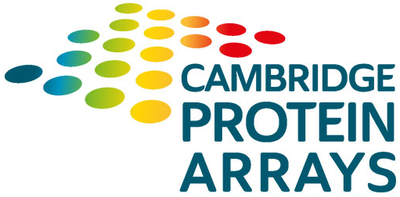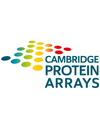

Cambridge Protein Arrays Ltd. (CPAP) applications
The concept behind protein arrays is the immobilisation of sets of proteins, up to very large numbers, on solid supports, to perform miniaturised, multiplexed binding assays with a variety of potential ligands or interactants (see powerpoint presentation on right). HuProt v4 human proteome arrays as used at CPA comprise full length human proteins, many of which will retain their native conformation. HuProt arrays can be distinguished from arrays of peptides, used primarily to identify linear epitopes, or protein fragments, which may have some conformation but not necessarily that of the native protein.
Comprehensive antibody reactivity profiling: validate specificity, identify cross-reactions. The issue of antibody cross-reactivity is one that has often been often overlooked or sidelined in the past, with typical antibody QC involving evidence of binding to the intended target, while neglecting potential cross-reactivity. In recent years, however, many examples have come to light where poor validation of antibodies has led to misleading or erroneous conclusions for assays in which they are used as reagents, due to unrecognised cross-reactions and even a failure to react with their supposed target altogether. It is now clear that off-target reactions can severely compromise an antibody’s usefulness and the interpretation and reproducibility of results, damaging research credibility and with potentially dangerous consequences in the diagnostics field.
Discover autoantigens in autoimmune diseases, delineate new candidate biomarkers. Autoantibodies are present in the blood of all healthy individuals. However, when directed at high levels against protein targets in specific tissues, autoantibodies can be a major cause of autoimmune diseases. They are also important biomarkers for diagnosis of these conditions.
Determine the interactome of your favourite protein. HuProt arrays provide a primary platform for screening proteins for binary interactions with the world`s largest collection of human proteins immobilised on a single microarray. Over 20,000 potential interactions are assessed in a single experiment. Array screening facilitates detection of interactors with low abundance in cellular systems. Combined with other data, the array output can confirm known interactors and discover new ones, illuminating the protein interaction network, identifying unexpected pathway involvement, as well as disease associations and potentially druggable targets. Novel identified interactors can be validated subsequently in alternative systems.
Identify interacting proteins for your DNA/RNA molecule of interest. Profiling of nucleic acid binding on HuProt human proteome microarrays can reveal interactions with the largest collection of individual human proteins available on a single slide. Nucleic acid-protein interactions regulate many aspects of gene expression and thus cell physiology and pathology. DNA-protein interactions occur via a range of binding motifs present in transcription factors and nuclear receptors (e.g. DNA-binding domains, zinc fingers, leucine zippers) and histones and nonhistone proteins interacting with chromatin, all of which can influence gene expression. For RNA, hundreds of RNA binding proteins (RBPs) have now been identified which interact with mRNAs, noncoding RNAs, microRNAs etc. and are involved in post-transcriptional gene regulation including gene silencing by RNAi.
Explore interaction profiles and identify off-target binding. Most drugs in common use are small organic molecules which interact functionally with proteins, either acting as ligands for receptors, inhibiting enzymes or blocking protein interactions, etc. Their activities have generally been established by specific cellular and molecular assays to determine mode of action. While frequently well tolerated, side-effects are nevertheless commonplace and can be the result of unexpected interference with unintended pathways in poorly understood ways. The consequences of off-target interactions may be clinically serious.
Protein arrays are exposed to enzymes to identify targets for post-translational modifications. Many key protein functions require the protein to undergo a post-translational modification (PTM), examples ranging from phosphorylations and glycosylations to histone modifications and ubiquitinations. HuProt human proteome microarrays can be used for profiling the targets of enzymes producing PTMs and have been used in studies of phosphorylation, glycosylation, sumoylation, etc.

